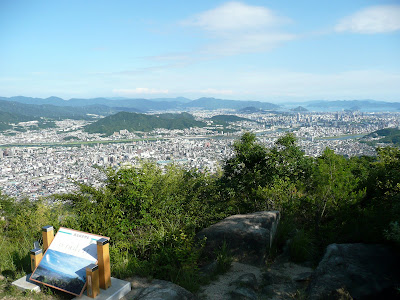It doesn't take long living in Japan to start feeling like "Seen one temple, seen 'em all." Sure, some of them really are extraordinary, but a lot of temples just look pretty much the same. So I guess that's why I wasn't in a huge rush to see Mitaki. I figured, yeah, I'm sure it's pretty, but what's the rush?
So one recent Sunday while Joe had something else to do, I rode the train 10 minutes from our apartment and hiked up the hill to the temple grounds (have you noticed these things always seem to be uphill?). At the entrance, I was greeted by a line of buddhas and an old stone marker carved with the faces of two children wearing bright red knit caps that contrasted sharply with a light layer of moss.

The world that opened up before me as I climbed the steps into the forest was nothing short of stunning.
There are very few places that have given me the sense of wonderment and the excitement of discovery that I felt wandering the grounds of Mitaki. It was old, peaceful, and meticulously manicured, with Buddhist statues and stone carvings everywhere I looked.
All around me came the sound of rushing water from the three waterfalls after which the temple is named ("Mi" meaning "3", and "Taki" meaning "Waterfall"). Incense lingered in the air. Bits of sunlight streamed through the lush trees that shaded the grounds, giving the whole place a kind of soft green glow.
The last time I can remember feeling this way was during my solo road trip through New England in 2004, when, driving down the freeway surrounded by mountains ablaze in autumn colors like some kind of living Monet painting, I wanted to press the accelerator to the floor and speed through every mile of those mountains, take it all in, discover the beauty over the next crest, around the next bend.
Tucked away in a little clearing was this nearly 500-year-old tahoto built in 1526. It was originally built in Wakayama Prefecture but it was moved to Hiroshima in 1951 to console the souls of victims who died in the atomic bombing.
Inside the tahoto is a seated wooden statue of a Buddha that dates back to the Heian Period (the years 794 to 1192). It's crazy to think about how old these things are, isn't it?
Walking further, there was a large bell beneath a pavilion like the one in Peace Park, and occasionally someone would swing the long wooden hammer and pray as the gong carried through the forest.
I watched a mother with her toddler go through the ritual and nearly cried at how cute the little boy was emulating her, head bowed, palms pressed tightly together under his nose. I wanted so badly to take his picture, but good manners trumped my impulses. I didn't want to be the obnoxious gaijin intruding on a solemn moment.
Further up the path, something I certainly wasn't expecting to find was a memorial to the concentration camp victims of Auschwitz.
I love the look of the inscription on the back of the marker.
The largest of the three waterfalls was a tall, slender stream tumbling over a giant cliff, though with all the greenery I couldn't get a clear photograph.
Up a bunch of steps to the temple itself, I was immediately struck by this horrific wooden statue in the entryway.
It was tough to get a good picture due to the darkness inside the temple and the bright daylight outside. But is this thing wild, or what? It's so graphic. I couldn't stop staring at it.
I don't know what this statue is supposed to represent, but the temple is dedicated to Kannon, the goddess of mercy. So I find it a little puzzling that there's a crazed monster on the front step about to smash out the brains of an infant.
These sights were fascinating, but the best was yet to come. Following the path up the hill past the temple, I found myself in a magnificent bamboo forest. The beauty of this place is just beyond words. It was so peaceful. You can feel the spirit of this place, so palpably alive.
I hadn't planned on climbing Mt. Mitaki, but after making my way through the bamboo trees, my exuberance carried me the rest of the way. Here's me at the top:
 |
| Mitaki Temple |

































